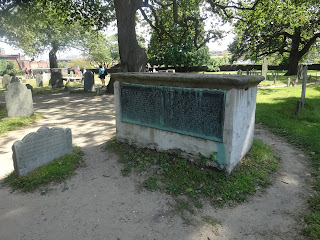Tuesday, October 15, 2019
Simon Bradstreet (or, Reduce, Reuse, Recycle)
Let's get back to talking about notable graves in the Charter Street Cemetery.
On the western side of the cemetery (over on the right-hand side, as you enter through the main gate) you will find the impressive box tomb of Governor Simon Bradstreet, one of the most active figures in colonial politics. He was a magistrate, a businessman, a diplomat, and of course Governor. Cotton Mather called him "the Nestor of New England," referring to the wise king from Homer's Odyssey. (But then again, Mather referred to my home state of Rhode Island as "the sewer of New England," and "the fag end of Creation," so I am not sure how much I trust his judgment here).
Regardless, Bradstreet does seem to have been an impressive character with a long list of credits to his name. He arrived in America aboard the Arbella in 1630, along with other Puritans as part of the "Winthrop Fleet,"dropping anchor at the end of my street(!). The huge plaque, placed on the tomb in 1917, describes him (in both English and Latin) as "A man endowed with keen judgement whom neither threats nor honors could sway."
He was twice married, both times to a woman named Anne. His first wife was the poet Anne Bradstreet, first American poet, or at least the first published American poet. You English majors in the crowd (like me) will remember reading her work in your survey Am Lit class.
"The Author To Her Book," is self-deprecating and pretty great --
Thou ill-formed offspring of my feeble brain,
Who after birth did'st by my side remain,
Till snatched from thence by friends, less wise than true,
Who thee abroad, exposed to public view,
Made thee in rags, halting to th' press to trudge,
Where errors were not lessened (all may judge).
At thy return my blushing was not small,
My rambling brat (in print) should mother call.
I cast thee by as one unfit for light,
Thy visage was so irksome in my sight;
Yet being mine own, at length affection would
Thy blemishes amend, if so I could:
I washed thy face, but more defects I saw,
And rubbing off a spot still made a flaw.
I stretched thy joints to make thee even feet,
Yet still thou run'st more hobbling than is meet;
In better dress to trim thee was my mind,
But nought save homespun cloth, i' th' house I find.
In this array 'mongst Vulgars may'st thou roam.
In critic's hands beware thou dost not come,
And take thy way where yet thou art not known;
If for thy Father asked, say thou hadst none;
And for thy Mother, she alas is poor,
Which caused her thus to send thee out of door.
And "To My Dear and Loving Husband" is written to Simon --
If ever man were lov'd by wife, then thee;
If ever wife was happy in a man,
Compare with me ye women if you can.
I prize thy love more than whole Mines of Gold,
Or all the riches that the East doth hold.
My love is such that Rivers cannot quench,
Nor ought but love from thee, give recompence.
Thy love is such I can no way repay,
The heavens reward thee manifold I pray.
Then while we live, in love lets so persevere,
That when we live no more, we may live ever.
Anne and Simon had eight children together (one died in infancy). She died in 1672 and is buried in North Andover. Simon went on to marry another Anne (the niece of Governor Winthrop) in 1676. He died in Salem at the ripe of age of 93, on March 27th, 1697.
But, you will say, you are spending a fair amount of time talking about the first Mrs. Bradstreet, who you admit isn't even buried in this tomb.
Don't worry -- neither is Simon.
In the late 1700s ("sometime between 1789-1796," according to William Carlson's "Charter Street Burial Records, Salem, Massachusetts, Genealogical and Historical," 2009) the tomb changed hands and the new owner, Daniel Hathorne (Nathaniel's grandfather) cleaned it out(!), removing the remains of Simon and the second Anne.
What did he do with them? Where did they end up?
Nobody knows ...!
Subscribe to:
Post Comments (Atom)

"There had, it seems, been some truth in chimerical old Borellus when he wrote of preparing from even the most antique remains certain 'Essential Saltes' from which the shade of a long-dead living thing might be raised up." (H. P. Lovecraft, The Case of Charles Dexter Ward)
ReplyDeleteGlad to see you went back and got Carlson's book. Does he provide something like a map of interments? I'd like to see who's buried near Doraty Cromwell and the (willow?) stump that I think is just west of her grave.
ReplyDelete